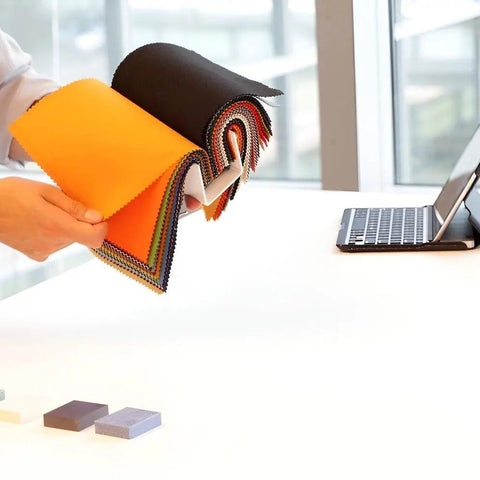We manufacture high-quality bean bags. Our company offers models specifically designed for swimming pools. However, these may eventually be affected by prolonged exposure to chlorine. Soaking in chlorinated water may subsequently cause the colours to fade over time. Chlorine is a potent chemical. All fabrics are adversely affected when they come into contact with it. Our floating pool bean bags are made of solution-dyed acrylic and olefin. These are some of the most chlorine-resistant fabrics available. Polyester and PBT blends are particularly resistant to chlorine, making them a preferred choice for use near pools. Fabrics like polyester and nylon are also valued for their fast-drying properties, which enhance convenience for swimmers. But does chlorine-proof fabric exist, or is long-term exposure always a risk?
Does Chlorine Resistant Fabric Exist?
Outdoor pools are subject to all the forces of nature. The wind blows dirt and grime into them. Unless you treat your pool water, bacteria, fungi, and other undesirable microorganisms will begin to grow. These quickly turn the swimming pool into a cesspool. Additionally, all the germs carried on and in the human body are washed into the water. Without some form of treatment, a pool will quickly spread infectious diseases. Swimming pools can be made sterile by adding a specific saline solution. However, saline is a costly option, typically used only in upscale fitness centres. The most popular method of sterilisation is to add a form of chlorine. Chlorine is the primary ingredient in bleach. Unfortunately, chlorine has the side effect of whitening coloured fabrics and eventually dissolving the threads. Because chlorine is so effective at killing germs, it is present in most water that passes through municipal water plants. However, the amount used in tap water is meagre. Otherwise, it would cause problems of its own, including the possibility of death. The amount of chlorine used in swimming pools is much less than that used for washing clothes, but higher than that in drinking water. When added to water, the measure for chlorine is parts per million (ppm). PPM is the ratio of chlorine to 1 million units of water. When using the standard guidelines for adding bleach to a top-loading washing machine, the amount of chlorine is just over 80 pp,m while the amount of chlorine in a swimming pool ranges from 1 ppm to 10 ppm.
Introduction to Chlorine-Resistant Fabrics
When you spend time in swimming pools, you quickly learn that chlorine is essential for keeping the water clean and safe. However, this powerful chemical can be tough on swimwear fabrics, often causing them to fade, lose their stretch, or wear out faster than expected. That’s where chlorine-resistant swimwear fabrics come in—these materials are specially designed to stand up to the harsh effects of chlorine, helping your swimwear last longer and look better.
Chlorine-resistant swimwear is typically made from polyester fabric, which is renowned for its durability, quick-drying properties, and resistance to fading. Polyester is less likely to absorb water and chemicals, making it an ideal choice for individuals who spend a significant amount of time in the pool. Unlike some other fabrics, polyester maintains its colour and elasticity even after repeated exposure to chlorine, so your swimwear stays comfortable and retains its shape.
While polyester is the top choice for chlorine-resistant swimwear, other fabrics like nylon and lycra are also used. Nylon is lightweight and stretches well, but it’s not as resistant to chlorine and may fade or lose its elasticity over time. Lycra and spandex are often blended with polyester to add stretch, but on their own, they can break down more quickly when exposed to pool chemicals. Cotton, though soft and comfortable, is not recommended for swimwear in chlorinated pools, as it tends to fade, stretch out, and wear thin much faster.
When shopping for chlorine-resistant swimwear, look for labels that mention “chlorine proof” or “chlorine resistant.” These products are designed to reduce the effects of chlorine, helping to prevent fading, stretching, and fabric breakdown. While chlorine-resistant swimwear may cost a bit more upfront, the investment pays off with longer-lasting colour, better fit, and greater comfort over time.
To get the most out of your chlorine-resistant swimwear, always follow the care directions on the label. Rinse your swimwear in clean water after each use to wash away chlorine, avoid using bleach or harsh chemicals, and store your swimwear in a cool, dry place. These simple steps can help reduce fading and keep your swimwear looking and feeling great.
Whether you’re a competitive swimmer or just enjoy relaxing in the pool, choosing chlorine-resistant swimwear fabrics like polyester can make a big difference. With the right fabric and a little care, you’ll enjoy swimwear that stays vibrant, comfortable, and ready for every swim.
The Effects of Chlorine on Fabric
One of the most well-known effects of chlorine is its ability to remove stains from white clothing. But it also has a bleaching effect on nearly all types of coloured fabric. When the concentration of chlorine exceeds 80 ppm, the reaction occurs almost immediately. However, at lower levels, the fading or whitening is gradual and does not become apparent until after multiple exposures over a period of time. You may have noticed that after several years of washing clothes, the colours will fade even without bleach. While there are other contributing factors, this is primarily due to the low chlorine content in the water. You may have also noticed that a new bathing suit noticeably fades after just one season of swimming in a pool. Bleaching can be faster in swimming pools if the chlorine concentration is higher. Chlorine has the additional side effect of compromising the fabric's integrity. The chlorine slowly eats away at the fibres, making them thinner and thinner. Eventually, the threads become so small and weak that they tear under regular use. Thread degradation due to chlorinated water is worse in natural fibres like cotton. While chlorine is an excellent solution for protecting swimmers' health, it is not so beneficial for fabrics. A few types of chlorine-resistant materials are available. But none of them is chlorine-proof. All fabrics will eventually succumb to the damaging effects of chlorine.
The Best Fabric for Pools
Although every natural and human-made fabric can be affected by chlorine, some are more resistant to bleaching than others. The worst of the bunch, however, is cotton. Cotton is soft, comfortable and affordable. However, its use for swimwear or products that are for use in or near swimming pools is rare. Chlorine will quickly bleach and degrade cotton fabric. Lycra and Spandex are synthetic fabrics commonly used in sportswear. But these are just as bad as cotton in chlorinated water because chlorine destroys the elasticity of these polyurethane-based materials. Making them brittle and causing them to lose their shape. Nylon stands up to chlorine much better than most other fabrics, and it dries quickly. However, the combination of chlorinated water and sunlight can still cause the colour of this fabric to fade within one year of regular use in swimming pools. Polyester swimwear, on the other hand, is more chlorine-proof and retains its colour better than nylon. The best fabric for swimming pools is solution-dyed acrylic or olefin. These two fabrics are exclusive to our floating pool bean bags. Polyester is highly hydrophobic, meaning it absorbs very little water. Most of the water fails to penetrate the fibres, helping to keep chlorine away from it. However, as mentioned above, no fabric is completely waterproof or fully chlorine-proof. Chlorinated water and sunshine will eventually cause the colours to fade, even in nylon and polyester. Those fabrics with a Colour Fastness to Chlorinated Water of Grade 5 are the closest you can get to a chlorine-proof material.
Fabric Care for Chlorine Pools
Because chlorine harms every type of fabric, including polyester, it is best to keep floating pool bean bags out of the water when they are not in use. Pool bean bags should sit in chlorinated pool water only during use. Remove your pool bean bagimmediately upon exiting the pool. By doing this, you will significantly extend the life of the outer fabric. For additional protection, we recommend covering the bean bag with a piece of thick, water-resistant fabric, such as a tarpaulin. Alternatively, store it indoors to protect it from the elements. The impact of rain and the ultraviolet rays of the sun can be just as damaging as chlorine is. You can keep colours sharp and reduce fading by rinsing them in clean water immediately after removing them from the pool. Rinsing swimwear in clean water immediately after use in the pool can help reduce fading and prolong the life of the fabric. Some people go even further by removing the cover and washing it with a small amount of non-chlorinated detergent. Having a removable inner liner is advantageous for washing your bean bag. However, it is always advisable to follow the cleaning instructions provided on the label or included with the product when purchased. Finally, a few specialised products are available for sale that can neutralise chlorine, removing any remnants. These are not necessary except in cases of extreme exposure. But some people swear by their effectiveness even with regular use. The products usually come in powdered form and are mixed with water. The fabric is then soaked in the mixture as directed. The two main ingredients to look for are sodium thiosulfate and sodium metabisulfite. However, these two chemicals are hazardous.




